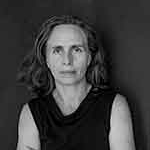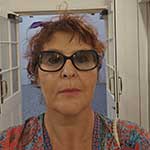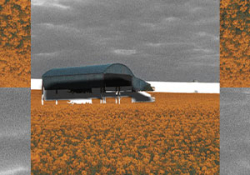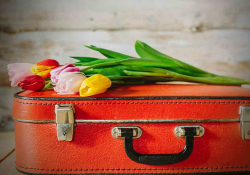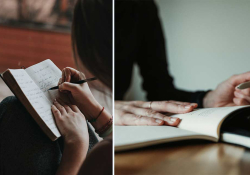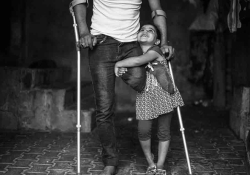Tongue in Mouth

In the dentist’s chair with mouth wide open, a patient contemplates her tongue’s relationships to B6 or B7, how shade 2 benefits an ex-smoker, and the complex connections between teeth and home.
So she’s ready to discuss the issue of foreign tongues, or to put it differently, the issue of one’s own foreign tongue in the mouth, with Dr. Rostam.
The windows of the dental surgery decorated in green open onto a large, spacious garden. This is the garden of a newly built row of houses, one of which is a peaceful, two-story home for the elderly. There’s never any commotion around this building, as if it wasn’t yet open for business or all its residents had already passed away. Although the bright light above the dental chair has been left on after finishing with the previous patient, Dr. Rostam hasn’t yet invited his patient to take a seat in the comfortable grass-green chair. This creates the impression that it hasn’t yet been decided whether the patient has come to open their mouth or to get away with it by making an appointment for a later date. Dr. Rostam is talking about property prices in the area, pointing out how shockingly high they are. He also flags up the latest football match, won by us greens, but only after extra time, despite playing on home turf. It was such a depressive match, he concludes with a sad face, without making it clear how playing on home ground can contribute to victory.
“How are you doing?” he asks at long last, still refraining from inviting his patient to take a seat and continuing this no-nonsense conversation. “We’ve seen each other fairly recently, haven’t we? How’s your new bridge?
The new bridge is great, in its own way, the patient adds swiftly, even though she much preferred her crumbling teeth despite them being pretty useless at chewing in the end, after all they had plenty of time to get used to each other over forty-odd years. Having said that, the new bridge is quite satisfactory, and she can now actually chew with the upper B6. Could the dentist please take a look at the lower B7, or perhaps B6 on the other side, not sure which one, and perhaps round the edges off a little. It’s really annoying. Especially when reading out loud. It feels like new, and adopting Dr. Rostam’s style, she adds, even though we haven’t touched these teeth at all. Yet they feel as if somehow they weren’t really her own.
“Do you read out loud a lot?” the dentist asks sympathetically, as if he was talking to a really special patient whose mouth and teeth were equipped to accomplish extraordinary tasks.
“No, not anymore,” the patient replies, hardly ever. Mainly because of this problem.
Dr. Rostam spends ages examining the erosion patterns on the lower back teeth, takes three different impressions one after the other, smooths and rounds off the smaller premolar, and after the fifth attempt, the patient finally concludes that it’s much better.
During the next appointment, this time for scaling, she cautiously asks whether it’s actually possible for someone’s tongue to grow in the mouth.
“What do you mean?” Dr. Rostam asks in a serious voice; he always treats his patients as if they were his guests, weighing up and pondering their questions.
The circumference of her tongue simply keeps growing. This makes her feel as if there wasn’t enough space in her mouth, she explains.
This tends to occur in cancer patients, and when there is an inflammation elsewhere in the body or even in the mouth, Dr. Rostam replies in a colorless voice. He recommends taking a blood test.
Not aware of any tumor, the patient responds falteringly, though it does feel as if she had a foreign object in her mouth, she adds in an awkward yet confidential tone.
“I also have this feeling from time to time,” Dr. Rostam muses, getting carried away with thoughts.
He looks out onto the peaceful garden, where a bunch of linden trees have joined together.
“I’ve been thinking that this may have to do with the fact that I only learned this language at the age of two, as until then we only spoke Farsi at home. You know, I’ve told you that I arrived in this country aged two. First, I’ve been talking through my nose somehow, just like my father. Like gypsies, you know. I’m not a linguist, so I don’t know about such things, but perhaps this is the norm in Persian, or perhaps this was the way my father was able to speak for some reason. I only got to learn to form sounds in my mouth at a later stage.”
The dentist takes another impression.
“I’ll work a bit more on the 6.”
As he’s carrying on with the back tooth at a leisurely pace, he returns to his story. He actually visited a specialist back in the day when he was doing his practical training. This was a speech therapist, whose job was to teach elocution techniques to acting students.
“Imagine, the therapist said that my speech was perfect. Literally perfect, also adding that he’d be thrilled if his lazy acting students were able to utter such perfect sounding vowels. He also praised my s.”
“Well, the s is a big problem for me. Especially the s. But other sounds, too,” the patient replies. It seems as if her tongue wouldn’t fit in the mouth when trying to pronounce the s, when the back of the tongue, that muscular body of the tongue, would have to reel up in the mouth.”
“I see. I’ll smooth it further then. By the way, the therapist was praising my breathing, too. I don’t dare to shave down any more, as I don’t want to end up under the enamel. But I take your point about foreignness. I can hear it, too. That of my own.”
Yet the sensation of foreignness in the mouth doesn’t go away.
Yet the sensation of foreignness in the mouth doesn’t go away. It’s most obvious when she has to read something out, at a steady pace, loudly and articulately in front of an audience. Her tongue, like a heavy inelastic block, is barely rolling, always smashing into either the B6 or the B7, or even the barely there yet still semiprotruding B8, the latter seemingly displaying sharp edges despite Dr. Rostam’s attempts at smoothing it at least six times with that slow but extremely loud drill. The text intended for reading out loud has become inaccessible in the course of the process, despite consisting of her own sentences, woven together slowly and meticulously. She can no longer relate to it, and, what’s more, the words pulverize like sawdust as soon as they are uttered and said out loud. Does that make sense? As if she wasn’t talking, but something entirely different was going on. Some sort of a background noise. Something quite unusual.
The words pulverize like sawdust as soon as they are uttered and said out loud.
She no longer takes on public readings. Spectators sitting in the dark auditorium while she’s bathed in harsh reflector light, she can’t even see those she’s addressing except for the blurred faces in the first two or three rows, and there are these sawdust sentences and the agony with her own tongue—she can’t cope with this anymore. She can’t say anymore on the topic, but it’s due to a physical impediment, she points out whenever they ask her to take on an assignment.
“Don’t you think that we may be trying too hard at work?” Dr. Rostam continues. “I got to this conclusion when I was talking to the speech therapist. I was at the start of my career then, and it was very important for me to get everything right. With the therapist, we went as far as recording and measuring the sounds I uttered; since you work with languages, you must know that this is a form of science. We took these measurements, and the speech therapist demonstrated that everything was sounding exactly as it should, it’s exactly as long and deep and high as required. Back then there were no monitors or computers, so the machine charted everything on a piece of paper, like an EEG. Everything was just perfect. Perhaps this is our problem.” The dentist lets out a laugh. In this summer heat he no longer looks foreign but suntanned, his skin and hair barely darker than that of anyone else. “We’re simply too good, don’t you think?”
She would have had the opportunity to have her large, dark amalgam fillings replaced with pretty, white ones in two, maximum three appointments. Wisdom tooth, for, Hiding in the mouth, / The ruins of the Parthenon cleaner, as Joseph Brodsky writes, preoccupied, like all poets, with foreign matter in the mouth.1 These heavy amalgams could easily be replaced with some inconspicuous foreign matter, a filling or overlay in a carefully coordinated shade, in his case 2, as befits an ex-smoker. It wasn’t the considerable time or financial investment that held her back, and not even the lack of self-concern. Even though Dr. Rostam had enough on his plate already not to have to seek out additional commitments, he felt that it was his professional duty to inform his patient about these options early on.
“Some people have such old fillings replaced. We remove them, clean the area and take a look underneath,” the Persian dentist sums up the process, after completing the “bridging” in four sessions, as promised. “Let me know if you’d be up for this.”
“Is this a necessity?”
“Well, it’s a possibility,” he smiles emphatically.
After that, they’ve never really touched on this topic again. Still, this possibility has come to her mind every now and then, mainly as a way of killing time, to literally chase it away or fill it with sensible content, as if it were some empty bottle in which she could place an actual message to the past. I’m done with you, amalgam fillings. In this time-gap, where, using her favorite Russian phrase, there was от нечего делать,2 and, as a result, she was overwhelmed with inertia, she could have had them replaced indeed, even if not with sparkling white but with the recommended shade 2 composite filling, in lieu of the old gray metal mixture, of mercury and another metal, perhaps silver. Yet she was absolutely convinced that emptiness could not be filled up, not even with a matching color. In that shared mouth and shared past, the Painter, a recent acquaintance from home, was also sporting amalgam fillings, who’d now simply ask, when finding her sitting on a stool by his hospital bed upon waking, whether she minded witnessing him put his teeth back in.
Or to be precise, other people’s teeth—because his own have long been lost somewhere. In his new homeland.
He adds that he wouldn’t even mind not having them in, except when really necessary. But he can’t speak without teeth, seeing that sounds cannot be formed in his mouth in the absence of teeth. The head is the only body part studied to some extent by all portrait artists, but the tongue is your domain, he makes a stand. Without his teeth, he speaks in a soft childish voice and his words blur together.
Dr. Rostam, known as the Persian, was only two when he arrived in his new and ultimate homeland, which he’d often describe as dearly loved and only rarely find faults with. His accent was perfect, much to his pride, resembling the speech pattern of newsreaders, achieved no doubt at the expense of intense facial muscle work. In short, he spoke the language to perfection. After all, those who arrive have the duty (or possibility?) to acquire perfection. It was precisely this confident perfection that gave his rarely and vaguely revealed foreignness away. At the age of two, he couldn’t have brought any foreign fillings with him, but while pairing his excessively articulate sentences with a soft and sympathetic intonation, he senses that his patient’s attachment to her fillings is rooted in an unnamable stubbornness. Like cement, this stubbornness doesn’t let this foreign matter go, not to mention that it’s also irrational and utterly pointless, as it is an attachment to its own striking foreignness. Dr. Rostam is most sympathetic toward this human stubbornness, in relation to which he chooses not to take a stand, seeing that the oath he had taken only covered healing and not . . . At this point, he gets stuck and is looking for the right term, would this be a matter of beautification or perhaps modernization? As it happens, the patient comes to his aid in no time.
“We can replace these fillings when they fall out,” the owner of the teeth announces, with the confidence of someone who takes their own decisions in such matters.
The other teeth take up all the time, they need bridges and root treatment involving an awful lot of effort, but these amalgams are simply unwavering.
In her new homeland, she only got her first filling after she had found herself with less holiday time; she could no longer jump on the first train, like in her student days, every time she had a toothache or a hole, or just lost a filling. She had never managed to get into tooth brushing, she’d always brush her teeth without any conviction or passion, unlike the American boy she used to bump into in the college bathroom during her first visit. That boy would carry on brushing his teeth for minutes on end—during which time, she’d go to the toilet and take a shower—he’d just stand in front of the mirror with an otherworldly face, brush his teeth, and stare at the ceiling as if he was admiring the frescoes in the Sistine Chapel.
She wouldn’t make a proper American, for that she’d have to be in a much deeper and more loving relationship with her own teeth.
So she went to the local health center with this freshly discovered hole in her tooth. Looking into this unknown mouth opening wide in front of their eyes, the flabbergasted dentist, clearly committed to the profession of dentistry with all its history, couldn’t refrain from asking with genuine curiosity for the unknown:
“So where do you come from?”
Having her mouth propped wide open and kitted out with a saliva extractor that painfully drilled into her soft lower palate, she couldn’t respond. By the time these tools and tampons were finally removed, the dentist was no longer interested in this piece of personal history.
Translation from the Hungarian
